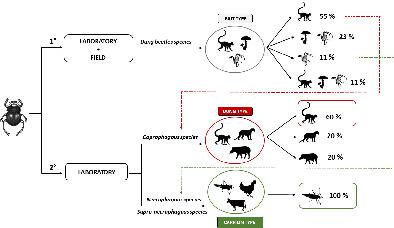当前位置:
X-MOL 学术
›
Ecol. Entomol.
›
论文详情
Our official English website, www.x-mol.net, welcomes your feedback! (Note: you will need to create a separate account there.)
Dung beetle trophic ecology: are we misunderstanding resources attraction?
Ecological Entomology ( IF 2.2 ) Pub Date : 2020-12-18 , DOI: 10.1111/een.13001 Victoria C. Giménez Gómez 1 , José R. Verdú 2 , Santiago J.E. Velazco 1 , Gustavo A. Zurita 1, 3
中文翻译:

ung虫营养生态学:我们误解了资源吸引吗?
更新日期:2020-12-18
Ecological Entomology ( IF 2.2 ) Pub Date : 2020-12-18 , DOI: 10.1111/een.13001 Victoria C. Giménez Gómez 1 , José R. Verdú 2 , Santiago J.E. Velazco 1 , Gustavo A. Zurita 1, 3
Affiliation

|
- Trophic ecology of dung beetles has been widely studied because of the important ecological role of these taxa. However, previous studies have focused on a limited number of potential food items (mainly vertebrate dung and carrion) and have used only one approach (either field or laboratory). Moreover, recent studies showed high abundance of dung beetles in defaunated areas with a low abundance of these resources.
- In this study, we combined a field and laboratory approach to explore dung beetle trophic attraction to different potential native resources in the Atlantic forest; and we evaluated whether results can explain the high abundance of dung beetles in defaunated areas. Through laboratory olfactometry experiments, we first exposed individuals to vertebrate carrion, omnivorous dung, and decomposing fungi. Then, we exposed species that exhibited a preference for dung to monkey, tapir, and feline dung; and those that preferred carrion and decomposing fungi to chicken, cow meat, and arthropod carcasses. We compared trophic attractions in the field and laboratory conditions with generalised additive models.
- We found that coprophagous species preferred monkey dung, and all necrophagous and sapro‐necrophagous species preferred arthropod carcasses. These results suggest that the importance of arthropods carcasses as an important resource for dung beetles has been largely underestimated.
- The results of this study might provide an explanation for the high abundance of necrophagous and sapro‐necrophagous dung beetles in defaunated areas. In addition, the use of omnivorous dung and arthropod carcasses could be an effective sampling method for dung beetle assemblages.
中文翻译:

ung虫营养生态学:我们误解了资源吸引吗?
- 由于这些类群的重要生态作用,已对粪便甲虫的营养生态进行了广泛的研究。但是,以前的研究集中在数量有限的潜在食品(主要是脊椎动物的粪便和腐肉)上,并且仅使用了一种方法(田间或实验室)。此外,最近的研究表明,在被淘汰的地区,甲虫的丰度很高,而这些资源的丰度却很低。
- 在这项研究中,我们结合了野外和实验室的方法来探索粪甲虫的营养吸引力,从而吸引了大西洋森林中不同的潜在原生资源。并且我们评估了结果是否可以解释被遗弃地区中甲虫的丰富程度。通过实验室嗅觉测定实验,我们首先将个体暴露于脊椎动物腐肉,杂食性粪便并分解真菌。然后,我们将对粪便表现出偏爱的物种暴露给猴子,tap和猫粪。以及那些喜欢腐肉并将真菌分解成鸡肉,牛肉和节肢动物尸体的动物。我们将田间和实验室条件下的营养吸引力与广义加性模型进行了比较。
- 我们发现,食腐动物更喜欢猴粪,而所有食尸和腐生食虫都更喜欢节肢动物尸体。这些结果表明,节肢动物尸体作为粪甲虫重要资源的重要性已被大大低估了。
- 这项研究的结果可能为在被破坏地区的大量食虫性和食尸性粪便甲虫提供了一个解释。此外,杂食性粪便和节肢动物尸体的使用可能是粪便甲虫组合的有效采样方法。



























 京公网安备 11010802027423号
京公网安备 11010802027423号